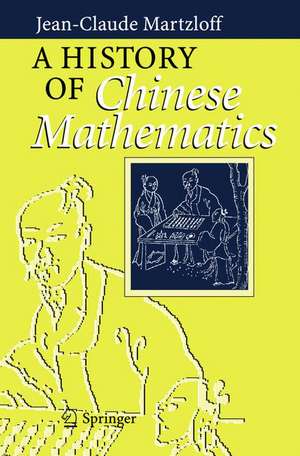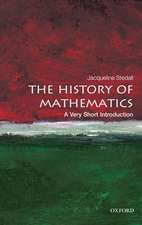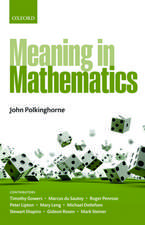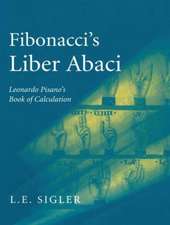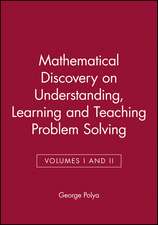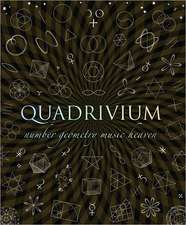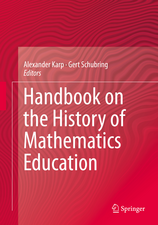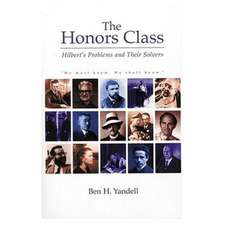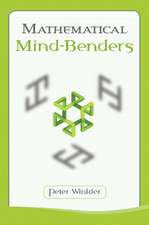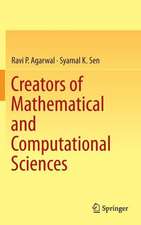A History of Chinese Mathematics
Traducere de S. S. Wilson Autor Jean-Claude Martzloff Cuvânt înainte de J. Gernet, J. Dhombresen Limba Engleză Paperback – 19 iul 2006
Preț: 524.98 lei
Preț vechi: 656.23 lei
-20% Nou
Puncte Express: 787
Preț estimativ în valută:
100.45€ • 109.46$ • 84.65£
100.45€ • 109.46$ • 84.65£
Carte tipărită la comandă
Livrare economică 19-25 aprilie
Preluare comenzi: 021 569.72.76
Specificații
ISBN-13: 9783540337829
ISBN-10: 3540337822
Pagini: 512
Ilustrații: 1
Dimensiuni: 155 x 235 x 27 mm
Greutate: 0.7 kg
Ediția:Softcover reprint of the original 1st ed. 1997
Editura: Springer Berlin, Heidelberg
Colecția Springer
Locul publicării:Berlin, Heidelberg, Germany
ISBN-10: 3540337822
Pagini: 512
Ilustrații: 1
Dimensiuni: 155 x 235 x 27 mm
Greutate: 0.7 kg
Ediția:Softcover reprint of the original 1st ed. 1997
Editura: Springer Berlin, Heidelberg
Colecția Springer
Locul publicării:Berlin, Heidelberg, Germany
Public țintă
ResearchDescriere
Since
the
end
of
the
19th
century,
a
number
of
specialised
journals,
albeit
with
a
large
audience,
have
regularly
included
articles
on
the
history
of
Chinese
mathematics,
while
a
number
of
books
on
the
history
of
mathematics
include
a
chapter
on
the
subject.
Thus,
the
progressive
increase
in
our
knowledge
of
the
content
of
Chinese
mathematics
has
been
accompanied
by
the
realisation
that,
as
far
as
results
are
concerned,
there
are
numerous
similarities
between
Chinese
mathematics
and
other
ancient
and
medieval
mathematics.
For
example,
Pythagoras'
theorem,
the
double-false-position
rules,
Hero's
formulae,
and
Ruffini-Harner's
method
are
found
almost
everywhere.
As
far
as
the
reasoning
used
to
obtain
these
results
is
concerned,
the
fact
that
it
is
difficult
to
find
rational
justifications
in
the
original
texts
has
led
to
the
reconstitution
of
proofs
using
appropriate
tools
of
present-day
elementary
algebra.
Consequently,
the
conclusion
that
Chinese
mathematics
is
of
a
fundamentally
algebraic
nature
has
been
ventured.
However,
in
recent
decades,
new
studies,
particularly
in
China
and
Japan,
have
adopted
a
different
approach
to
the
original
texts,
in
that
they
have
considered
the
Chinese
modes
of
reasoning,
as
these
can
be
deduced
from
the
rare
texts
which
contain
justifications.
By
studying
the
results
and
the
methods
explicitly
mentioned
in
these
texts
hand
in
hand,
this
Chinese
and
Japanese
research
has
attempted
to
reconstruct
the
conceptions
of
ancient
authors
within
a
given
culture
and
period,
without
necessarily
involving
the
convenient,
but
often
distorting,
social
and
conceptual
framework
of
present-day
mathematics.
Cuprins
The
Context
of
Chinese
Mathematics.-
The
Historiographical
Context.-
The
Historical
Context.-
The
Notion
of
Chinese
Mathematics.-
Applications
of
Chinese
Mathematics.-
The
Structure
of
Mathematical
Works.-
Mathematical
Terminology.-
Modes
of
Reasoning.-
Chinese
Mathematicians.-
The
Transmission
of
Knowledge.-
Influences
and
Transmission.-
Main
Works
and
Main
Authors
(from
the
Origins
to
1600).-
The
Content
of
Chinese
Mathematics.-
Numbers
and
Numeration.-
Calculating
Instruments.-
Techniques
for
Numerical
Computation.-
Geometry.-
Indeterminate
Problems.-
Approximation
Formulae.-
Li
Shanlan’s
Summation
Formulae.-
Infinite
Series.-
Magic
Squares
and
Puzzles.
Recenzii
From
the
reviews:
"...a truly scholarly and balanced exposition..."-Zentralblatt für Mathematik "...crammed with insights, cautionary tales and a great deal of information about current research... will surely become a standard reference for students, teachers and researchers alike" -Annals of Science
"Martzloff, together with Karine Chemla and Catherine Jami, is part of a French research group on the history of Chinese mathematics. Together, they have made substantial contributions to the field. In particular, they have brought to the field a more sophisticated and reflective attitude towards the writing of history. … Martzloff remains the best introduction to the subject and his ‘Bibliographical Orientation’ at the end should open up a huge world of texts and historical studies for anyone who wants to go further." (Fernando Q. Gouvêa, MathDL – Online, October, 2006)
"...a truly scholarly and balanced exposition..."-Zentralblatt für Mathematik "...crammed with insights, cautionary tales and a great deal of information about current research... will surely become a standard reference for students, teachers and researchers alike" -Annals of Science
"Martzloff, together with Karine Chemla and Catherine Jami, is part of a French research group on the history of Chinese mathematics. Together, they have made substantial contributions to the field. In particular, they have brought to the field a more sophisticated and reflective attitude towards the writing of history. … Martzloff remains the best introduction to the subject and his ‘Bibliographical Orientation’ at the end should open up a huge world of texts and historical studies for anyone who wants to go further." (Fernando Q. Gouvêa, MathDL – Online, October, 2006)
Textul de pe ultima copertă
For
the
English
language
edition,
this
completely
unique
book
of
J.C.
Martzloff
has
been
fully
revised
and
updated.
It
includes
many
new
recent
insights
and
illustrations,
a
new
appendix
on
Chinese
primary
sources
and
a
guide
to
the
to
the
bibliography.
From
the
reviews:
"This
book
ranks
with
the
most
erudite
Asian
publications,
and
is
the
most
informative
and
most
broadly
informed
on
its
topic
in
any
language."
N.
Sivin,
China
Quarterly
"...
crammed
with
insights,
cautionary
tales
and
a
great
deal
of
information
about
current
research
...
will
surely
become
a
standard
reference
for
students,
teachers,
and
researchers
alike",
J.
N.
Crossley,
Annals
of
Science
"...
a
truly
scholarly
and
balanced
exposition
...
a
book
that
the
reviewer
believes
belongs
in
the
library
of
every
university
or
college,
as
well
as
in
that
of
every
individual
seriously
interested
in
the
history
of
Chinese
mathematics",
B.
L.
McAllister,
ZBfM
"Martzloff
History
demonstrates
clearly
that
while
the
Chinese
were
adept
in
applying
their
mathematics
to
a
host
of
practical
problems,
including
astronomy
and
engineering
as
well
as
commercial
transactions,
they
also
paid
attention
to
algorithmic
techniques,
methods
of
calculation,
geometric
constructions,
and
even
certain
purely
logical
problems.
But
above
all,
what
sets
this
book
apart
from
the
usual
histories
of
mathemathics
(in
any
language,
Chinese
or
Western,
of
any
period
or
country)
is
its
emphasis
first
on
context,
then
on
content,
in
describing
the
long
history
of
Chinese
mathematics
....
It
is
primarily
the
question
of
context
that
Martzloff
approaches
directly.
Perhaps
the
greatest
contribution
his
book
makes
is
the
chance
it
offers
to
consider
issues
of
cultural
context
as
significant,
determining
factors
in
the
history
of
mathematics.
Thus,
Martzloff
tries
to
get
inside
the
Chinese
mind,
to
explain
how
and
why
mathematics
developed
as
it
did
in
China,
and
often
in
ways
strikingly
different
from
its
Western
counterparts.
Although
he
does
not
always
account
for
these
differences,
he
succeeds
admirably
in
describing
them,
which
results
in
a
refreshingly
rich
sense
of
its
evolution
as
well."
Joseph
W.
Dauben,
Historica
Mathematica
20,
1993
Caracteristici
Now
available
in
softcover
